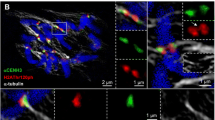Abstract
Root tip cells of broad bean (Vicia faba L. cv. ‘Wase soramame’) and barley (Hordeum vulgare L. cv. ‘Minorimugi’) were immunostained with antibodies specific for acetylated histone H4. With an antiserum that recognizes histone H4 acetylated at lysine-5, the nucleolar organizing region (NOR) in mitotic chromosomes was strongly labeled in both species. The broad bean had two signals in the metaphase and telophase chromosome complements and four signals in the prophase and anaphase chromosome complements, while the barley had four signals in the metaphase and telophase chromosome complements and eight signals in the prophase and anaphase complements. Five differnet patterns of signals were observed at interphase: in type I only nucleoli were wholly stained; in type II perinucleolar knob-like signals and/or fiber-like signals emanated from the nucleus; in type III aggregate signals appeared in the nucleolus in type IV many small dot-like signals were distributed throughout the nucleus, except nucleoli; and in type V string-like or some granule-like signals appeared in the nucleoli. Type II was very similar to previous results by in situ hybridization with sense rDNA probes. Type III was similar to the patterns of DNA synthesis recognized as chromatin domains by anti-BrdU antibodies. Type V was very similar to the results of in situ hybridization with pTa71, rDNA probes and the appearance of the dense fibrillar components of the nucleolus.
Similar content being viewed by others
References
Bradbury EM (1992) Reversible histone modifications and the chromosome cell cycle. BioEssays 14:9–16
Cardoso C, Leonhardt H, Nadal-Ginard B (1993) Reversal of terminal differentiation and control of DNA replication: cyclin A and Cdk2 specifically localize at subnuclear sites of DNA replication. Cell 24:979–992
Delgaro M, Moraris-Cecilio L, Neves N, Jones RN, Viegas W (1995) The influence of B chromosomes on rDNA organization in rye interphase nuclei. Chromosome Res 3:487–491
Evans HJ, Bigger TRL (1961) Chromatid aberrations induced by gamma irradiation. II. Non randomness of chromatid aberrations in relation to chromosome length inVicia faba root tip cells. Genetics 46:277–289
Gooderham K, Jeppesen P (1983) Chinese hamster metaphase chromosomes isolated under physiological conditions: a partial characterization of associated non-histone proteins and protein cores. Exp Cell Res 144:1–14
Hizume M (1992) Exact location of rRNA genes inVicia faba chromosomes. Cytologia 57:471–475
Hizume M, Tanake A, Miyata Y (1982) Behavior of silver stainable material during mitosis inVicia faba. Bot. Mag. Tokyo 95:81–87
Houben A, Belyaev ND, Turner BM, Schubert I (1996) Differential immunostaining of plant chromosomes by antibodies recognizing acetylated histone H4 variants. Chromosome Res 4:191–194
Jeppesen P, Turner BM (1993) The inactive X chromosome in female mammals is distinguished by a lack of histone H4 acetylation, a cytogenetic marker for gene expression. Cell 74:281–289
Krude T (1995) Chromatin assembly factor 1 (CAF-1) colocalizes with replication foci in Hela cell nuclei. Exp Cell Res 220:304–311
Matsui S (1974) Nucleolar organizer ofVicia faba chromosomes revealed by the N banding technique. Jpn J Genet 49:93–96
Rawlins DJ, Shaw PJ (1990) Three-dimensional organization of ribosomal DNA in interphase nuclei ofPisum sativum by in situ hybridization and optical tomography. Chromosoma 99:143–151
Shaw PJ, Rawlins DJ, Highett M (1993) Nuclear and nucleolar structure in plants. In: Heslop-Harrison JS, Flavell RB (eds) John Innes Review: the chromosome. Bios, London, pp 161–171
Schubert I, Anastassova-Kristeva M, Rieger R (1979) Specificity of NOR staining inVicia faba. Exp Cell Res 120:433–435
Steinemann M, Steinemann S, Turner BM (1996) Evolution of dosage compensation. Chromosome Res 4:185–190
Terasaka O, Niitsu T (1994) Kinesin localized in the pollen tube tips ofPinus densiflora. Jpn J Palynol 40:1–6
Turner BM (1991) Histone acetylation and control of gene expression. J Cell Sci 99:13–20
Turner BM, O'Neill LP, Allan IM (1989) Histone H4 acetylation in human cells. Frequency of acetylation at different sites defined by immunolabeling with site-specific antibodies. FEBS Lett 253:141–145
Turner BM, Franchi L, Wallace H (1990) Islands of acetylated histone in polytene chromosomes and their relationship to chromatin packaging and transcriptional activity. J Cell Sci 96:335–346
Turner BM, Birley AJ, Lavender J (1992) Histone H4 isoforms acetylated at specific lysine residues define individual chromosomes and chromatin domains inDrosophila polytene nuclei. Cell 69:315–384
Author information
Authors and Affiliations
Additional information
Edited by: W. Hennig
Rights and permissions
About this article
Cite this article
Idei, S., Kondo, K., Turner, B.M. et al. Tomographic distribution of acetylated histone H4 in plant chromosomes, nuclei and nucleoli. Chromosoma 105, 293–302 (1996). https://doi.org/10.1007/BF02524647
Received:
Revised:
Accepted:
Issue Date:
DOI: https://doi.org/10.1007/BF02524647




